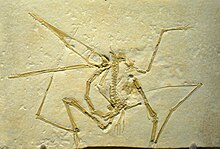Pterodactyloidea
| Pterodactyloids | |
|---|---|

| |
| Cast of a Pterodactylus antiquus specimen, Carnegie Museum of Natural History
| |
| Scientific classification | |
| Domain: | Eukaryota |
| Kingdom: | Animalia |
| Phylum: | Chordata |
| Order: | †Pterosauria |
| Clade: | †Caelidracones |
| Suborder: | †Pterodactyloidea Plieninger, 1901 |
| Subgroups | |
| |
| Synonyms | |
| |
Pterodactyloidea (derived from the
"Pterodactyl" is also a common term for pterodactyloid pterosaurs, though it can also be used to refer to Pterodactylus specifically. Well-known examples of pterodactyloids include Pterodactylus, Pteranodon, and Quetzalcoatlus.
In 2014, fossils from the
Classification
Pterodactyloidea is traditionally considered to be the group of short-tailed pterosaurs with long wrists (metacarpus), compared with the relatively long tails and short wrist bones of basal pterosaurs ("rhamphorhynchoids"). In 2004, Kevin Padian formally defined Pterodactyloidea as an
A subgroup of pterodactyloids, called the Lophocratia, was named by David Unwin in 2003. Unwin defined the group as the most recent common ancestor of Pterodaustro guinazui and Quetzalcoatlus northropi, and all its descendants.[7] This group was named for the presence of a head crest in most known species, though this feature has since been found in more primitive pterosaurs and was probably an ancestral feature for all pterodactyloids.[8]
There are competing theories of pterodactyloid phylogeny. Below is cladogram following a topology recovered by Brian Andres, using the most recent iteration of his data set (Andres, 2021). This study found the two traditional groupings of ctenochasmatoids and kin as an early branching group, with all other pterodactyloids grouped into the Eupterodactyloidea.[9]
| Caelidracones |
| ||||||||||||||||||||||||||||||||||||||||||||||||||||||||||||||||||||||||||||||||||||||||||
Some studies based on a different type of analysis have found that this basic division into primitive (archaeopterodactyloid) and advanced (eupterodactyloid) species may not be correct. Beginning in 2014, Steven Vidovic and David Martill constructed an analysis in which several pterosaurs traditionally thought of as archaeopterodactyloids closely related to the ctenochasmatoids may have been more closely related to ornithocheiroids, or in some cases, fall outside both groups. The results of their updated 2017 analysis are shown below.[10]
| Pterodactyloidea |
| ||||||||||||||||||||||||||||||||||||||||||||||||||||||||||||||||||||||||||||||||||||||||||||||||||||||||||||||||||||||||||||||||||||||||||
References
- ^ Colbert, Edwin H. (Edwin Harris); Knight, Charles Robert (1951). The dinosaur book: the ruling reptiles and their relatives. New York: McGraw-Hill. p. 153.
- ^ Review of taxonomy, geographic distribution, and paleoenvironments of Azhdarchidae (Pterosauria) – ZooKeys
- ^ PMID 24768054.
- ^ Michael O’Sullivan; David M. Martill (2018). "Pterosauria of the Great Oolite Group (Bathonian, Middle Jurassic) of Oxfordshire and Gloucestershire, England". Acta Palaeontologica Polonica. Online edition. doi:10.4202/app.00490.2018.
- ^ de Queiroz. K., Cantino. P. D., Gauthier. J. A. eds. (2020). Phylonyms: A Companion to the PhyloCode. CRC Press Boca Raton, FL
- ^ Unwin, D. M., (2003). "On the phylogeny and evolutionary history of pterosaurs." Pp. 139–190. in Buffetaut, E. & Mazin, J.-M., (eds.) (2003). Evolution and Palaeobiology of Pterosaurs. Geological Society of London, Special Publications 217, London, 1–347.
- ISBN 978-0691150611.
- ^ Andres, B. (2021) Phylogenetic systematics of Quetzalcoatlus Lawson 1975 (Pterodactyloidea: Azhdarchoidea). Journal of Vertebrate Paleontology, 41:sup1, 203-217. DOI: 10.1080/02724634.2020.1801703 https://www.tandfonline.com/doi/full/10.1080/02724634.2020.1801703
- doi:10.1144/SP455.12



